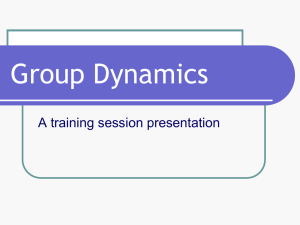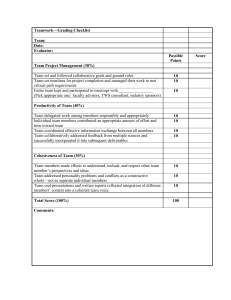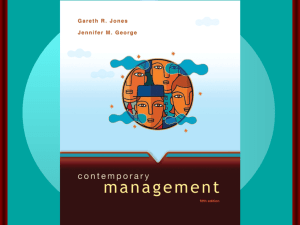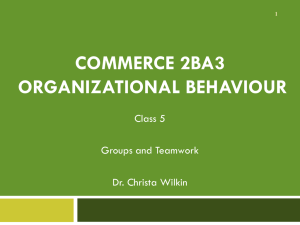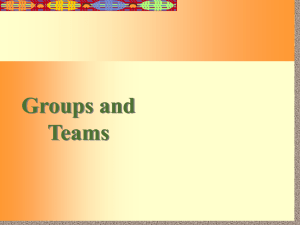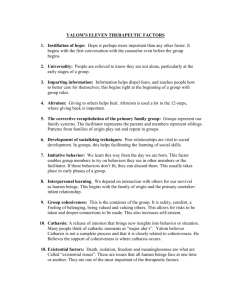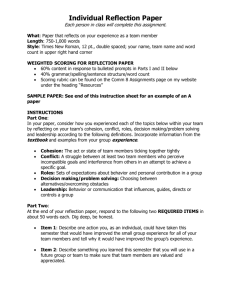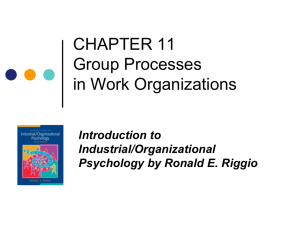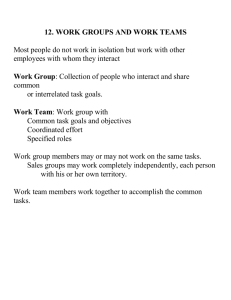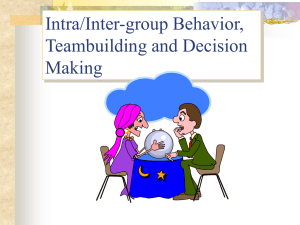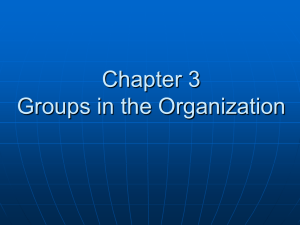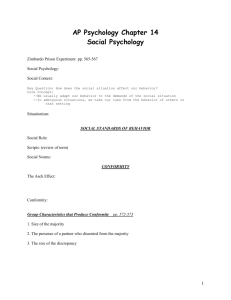Groups
advertisement
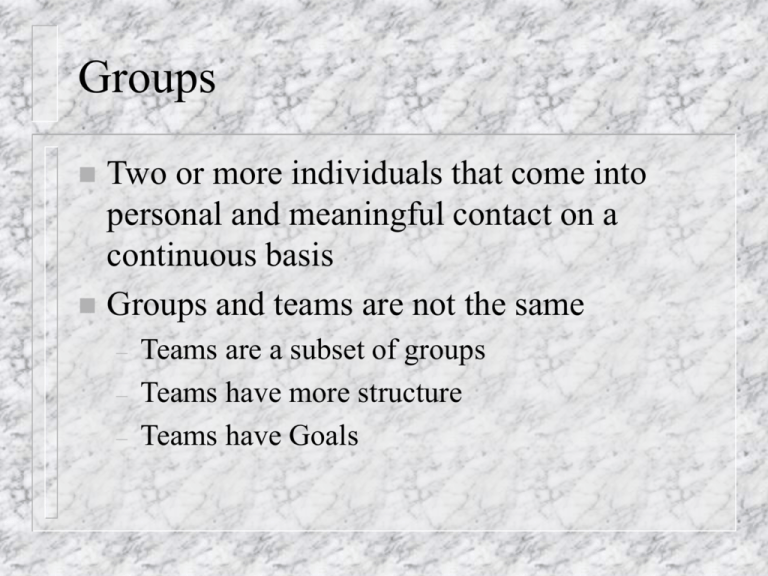
Groups Two or more individuals that come into personal and meaningful contact on a continuous basis Groups and teams are not the same – – – Teams are a subset of groups Teams have more structure Teams have Goals Group Dynamics Dynamics affect how a group or team functions. – Group size: affects how a group performs. Normally, keep group small (2 to 9 members). – Small groups interact better and tend to be more motivated. Use large groups when more resources are needed. – Division of labor is possible with large group. – Group Tasks: impacts how a group interacts. Task interdependence shows how work of one member impacts another. – As interdependence rises, members work closer together. Team Size Optimal Size???? Depends on task, group, time, etc. Should be large enough to provide sufficient ideas, and labor, but not so large that social loafing becomes an issue, and that the group becomes clumsily large Navy Seals in Panama Reducing Social Loafing Figure 14.7 Make individual contributions identifiable Emphasize valuable individual contributions Keep group size at an appropriate level REDUCE Social Loafing Group Dynamics – Task interdependence types: Pooled Task Interdependence: members make separate, independent contributions to group. – Sequential Task Interdependence: members perform tasks in a sequential order. – Group performance is the sum of member contributions. Hard to determine individual performance since one member depends on another. Reciprocal Task Interdependence: work performed by a member is dependent on work by others. – Members share information and work closely together. Processes of Groups Forming, Storming, Norming, Performing and Adjourning Groups move through the stages, can stop at a stage, or move back down through the stages The faster they move through the process the better 17.6 The Development of Work Teams Degree of Maturity High End or recycle End or recycle End or recycle End or recycle Adjourning Performing Norming Storming Forming Low Start Time Together Source: Adapted and modified from B.W. Tuckman and M. A. C. Jensen. Stages of small-group development revisited. Group and Organization Studies, 2, 1977, pp. 419-442; and B. W. Tuckman. Developmental sequence in small groups. Psychological Bulletin, 63, 1965, pp. 384-389. End Adapted from Figure 17.3 Forming-awareness stage Group is brought together and orientation occurs Become aware of friendships, task objective Amount of information and commitment and acceptance of organizational goals is important Anxiety about the group, the task, and performance capability Group efficacy-belief in groups ability Storming-conflict stage Competitive or strained behaviors emerge over conflict about roles and objectives Dominant members emerge Spreading conflict can lead to frustration, and anger Conflict resolution is necessary to move on Some conflict is beneficial Norming Members begin to feel positive about the group and what it is supposed to do Start to feel like “we are in this together” Roles are set Rules and norms are set and enforced by members Behavioral Norms Informal rules of behavior Widely shared and enforced by group Facilitate group survival – – – Predictability of behavior Prevents embarrassing situations Express important behaviors Dress, Humor, Attitude toward organization, what is ok to take from org Norm Development Explicit Statement by top management Critical events-precedence Primacy behaviors Recency Past experience-carry-over behaviors from other groups Group Cohesiveness – Group cohesiveness: measures the loyalty to the group by its members. Level of Participation: as cohesiveness rises, so will participation. – Level of Conformity: as conformity rises, so does cohesiveness. – Participation helps get members actively involved, but too much can waste time. With too much conformity, performance can suffer. Level of Group Goal Accomplishment: as cohesiveness rises, the emphasis on group accomplishment will rise. – High levels of cohesiveness can cause the group to focus more on itself than the firm. Cohesiveness – Determinates of cohesiveness: can be altered to change cohesiveness levels in a group. Group Size: small groups allow high cohesiveness. – Low cohesiveness groups with many members can benefit from splitting into two groups. Managed Diversity: Diverse groups often come up with better solutions. Group Identity: When cohesiveness is low, encourage a group to adopt a unique identity and engage in healthy competition with others. Success: cohesiveness increases with success. – Look for a way for a group to find some small success. Factors that influence cohesion Common Goals Success Experience Size Interpersonal Attraction External Threat High Status Cooperation Group Cohesiveness Figure 14.6 Group Size Managed Diversity Group Identity Success Level of Participation in group Group Cohesiveness Level of Conformity to norms Emphasis on goals accomplished Groupthink Desire to agree is so great that is dominates concern for realistic appraisal of alternative courses of action Too much cohesion or domination of group by a few leaders Time pressure, need to perform, crisis conditions Productive Controversy Productive Controversy – between extremes of infighting and groupthink Also known as creative abrasion value different points of view Facilitates creative problem solving Task related conflict is good, personal is not so good Balancing Conformity and Deviance Figure 14.5 Level of group Performance High Low Low Conformity High deviation Med. Conformity Med. deviation High Conformity Low deviation Performingproductivity/achievement Members have come to trust and accept each other Members comfortable presenting ideas Team is focused on task, committed to the mission Adjourning-separation For temporary (task force) teams Terminating task behaviors Disengaging from relationship Isn’t always planned Recognition for performance and give closure May be turnover of members rather than adjournment Groups & Teams Impact Effectiveness Figure 14.1 Enhance Performance Groups and Teams Can... Increase Responsiveness to customer Increase Innovation Increase Motivation & Satisfaction Gaining a Competitive Advantage Types of Groups and Teams Figure 14.2 Groups & Teams Formal Groups created by managers CrossFunctional Teams CrossCultural Teams Top Mgmt. Teams R&D Teams Informal Groups created by workers SelfManaged Teams Command Groups Friendship Groups Task Forces Interest Groups Informal Groups Small number of individuals that frequently participate together in activities and are more connected to each other than to nonmembers – – Share values, feelings, interests Provides satisfaction of personal needs, mutual support Can be beneficial or detrimental to organizations Work Teams Small number of identifiable, interdependent employees that work together on tasks in order to achieve organizational goals – – – – – Functional Problem-solving Self-managing Multidisciplinary High-performance teams Functional Work Teams Members from a single department Consider issues and solve problems May be continual or May be task force that disbands after completion of assignment Problem-Solving Members from different areas in a department that attempt to improve a process – – Task forces-meet to move the organization toward a new strategic position Quality circles-regular meetings to identify, analyze, solve problems Multidisciplinary Teams Members from various areas and organizational levels that work toward specific goals – – – Designing and introducing products Improve company match with suppliers and customers Design and introduce new processes Permanent or temporary Product development-Saturn Advantages of Multidisciplinary Speed in product development – – replaces serial development with parallel development communication through levels of organization Creativity – variety of experience and expertise Self-Managing Teams Work together daily to make, deliver an entire product or service Often multidisciplinary Rotating job tasks and assignments Decide for themselves what and how to do things Can raise productivity 30% Managerial levels often eliminated High-Performance Teams Self-managing teams composed of highly trained members Fully empowered to accomplish major tasks US Navy Seals SWAT and SRT teams Members must put group ahead of personal ego and be totally committed to group initiatives Culture’s Effect on Groups Collectivist Vs Individualistic Cultures – collectivists are more comfortable in groups Japan, – Latin-American individualistic are less comfortable US In individualistic countries groups must be supported by organizational culture Organizational Culture Traditional Organizations depend upon stable functional teams without multidisciplinary work Modern organizations strive to be more adaptive through use of multidisciplinary teams – Most employees serve on multiple multidisciplinary teams at one time
